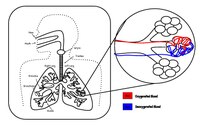
Photo from wikipedia
Abstract The adsorption of three gases on the wurtzite GaAs nanowires (100) surface are systematically studied via first principles. The optoelectronic properties of GaAs nanowires absorbed by CH 4 ,… Click to show full abstract
Abstract The adsorption of three gases on the wurtzite GaAs nanowires (100) surface are systematically studied via first principles. The optoelectronic properties of GaAs nanowires absorbed by CH 4 , H 2 and H 2 O are analyzed. The surface absorbed with H 2 O has the lowest adsorption energy, thus it is the easiest to adsorb on the surface. The gas adsorption makes the increase of band gaps, work functions and surface electron affinity, especially H 2 O adsorption system with the largest band gap of 1.34eV. The adsorption of these gases generates a dipole moment pointing from the GaAs nanowires to the residual gas molecules. For H 2 O molecular adsorption, which impedes the electron emission and decrease electrons emission capacity. The surface structures also reconstruct with different degrees. The residual gas adsorption can greatly affect the optical properties of the surface and undermine the performance of GaAs nanowire, particularly H 2 O adsorption. This work can help to understand the fading mechanism of the performance of optoelectronic devices based on GaAs nanowires.
Journal Title: Physica B: Condensed Matter
Year Published: 2019
Link to full text (if available)
Share on Social Media: Sign Up to like & get
recommendations!